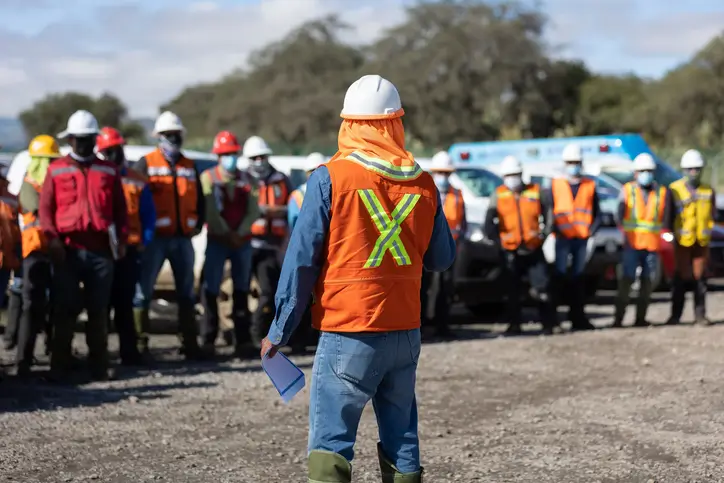25 Shocking Workplace Safety Statistics: Are You at Risk?
Updated on:
July 23, 2025
Published on:
July 23, 2025
Behind every statistic lies a story. Workplace safety facts are not just numbers on a page; they represent lives, livelihoods, and the well-being of individuals. Some of these numbers tell a shocking tale of apathy toward the hard workers in industries like construction, mining, demolition, and manufacturing.
In this article, we delve into the workplace safety statistics that explain how the matter of precaution and hazard identification at worksites is a matter that requires your immediate attention.
25. Some Interesting Workplace Safety Facts
Here are the OSHA FACTS AND STATISTICS that shed light on the urgency of workplace safety.
Let’s dive in.
1. The Alarming Rise of Workplace Injuries in the United States
According to the U.S. Bureau of Labor Statistics, in the United States, there were nearly 5,333 severe workplace injuries in 2019. A 2% rise from 5,250 recorded in 2018. In 2021, a worker would pass away from a workplace injury every 101 minutes.

2. The Persistent Problem of Workplace Illnesses and Injuries

By the employers of private industry, it has been reported that there were almost 2.6 million illnesses and injuries in 2021. There might be a 1.8% decrease in diseases from 2020 (from 544,600 to 365,200 in 2021) in private organizations.
3. The Grim Reality of Workplace Fatalities: A Global Crisis
Every year, a minimum of 108 thousand employees die at their workplaces, which accounts for 30% of all fatal accidents and severe injuries. According to data from several developed nations, construction workers have greater chances to die in the workplace and roughly 3 to 4 times more chances than other industry workers.

4. The Rising Toll of Transportation-Related Workplace Injuries

With 2,122 cases, transportation incidents reached a record high in 2019. This represented an increase of 2%. The most severe work-related injuries happened due to material moving and transportation, and on average, there were 1,523 deadly workplace injuries in 2021. It was a significant rise of 18.8 as compared to 2020. But they are still 6.6% down from 2019.
5. The Devastating Impact of Falls, Trips, and Slips: A Leading Cause of Workplace Fatalities
Due to falls, trips, and slips, there were almost 880 fatalities, which might rise up by 11% from 2018. Fire and explosion-related workplace fatalities declined 14% from 115 to 99 in between. Almost 66% of Latino workers were killed while performing their everyday tasks at the workplace; It has been recorded a total number of 1088 non-American citizens.

6. The Rising Threat of Hazardous Substances: A Deadly Trend in the Workplace

In 2021, the number of fatalities increased due to exposure to hazardous substances, and it has led to 798 employees. It might be considered the highest figure compared to other years. This category experienced a significant increase in deaths, almost 18.8%, from 2020 to 2021.
7. The Global Threat of Workplace Exposures: A Silent Killer
Due to falls, trips, and slips, there were almost 880 fatalities, which might rise up by 11% from 2018. Fire and explosion-related workplace fatalities declined 14% from 115 to 99 in between. Almost 66% of Latino workers were killed while performing their everyday tasks at the workplace; It has been recorded a total number of 1088 non-American citizens.

8. The Rising Toll of Transportation-Related Fatalities: A Growing Concern for Workers

From 887 casualties in 2020 to 1032 deaths in 2021, the number of fatalities of truck drivers and sales workers increased by 16.3%. Transportation is one of the major causes of an increase in workers’ death rate.
9. The High Cost of Workplace Injuries: A Financial Burden on Businesses
According to Liberty Mutual’s 2021 Workplace Safety Index, companies in 2018 spent more than $1 billion per week on direct workers’ compensation payments for incapacitating, non-fatal workplace injuries.

10. The Staggering Cost of Workplace Injuries: A Financial Burden on Society

Injuries at work cost an estimated $167.0 billion in 2021. This amount accounts for $47.4 billion in lost wages and productivity, $36.6 billion in medical costs, and $57.5 billion in administrative costs.
11. A Closer Look at OSHA’s Budgetary Growth and Spending
The federal agency’s budget has grown by $10 million since 2020, when it was $581,787,000 a year. The total annual spending for OSHA in 2019 was $597,787,000. In 2022, OSHA has a budget of 591,787,000 U.S dollars.

12. The Limited Reach of OSHA: One Inspector for Every 70,000 Workers

Despite the fact that OSHA’s federal branch only has 10 regional offices & 85 local offices. However, each of its state affiliates has over 8 million workplaces worldwide. This is around one OSHA inspector out of every 70,000 U.S. workers, including 1850 state and federal regulators.
13. Manufacturing Workers Face Highest Risk of Occupational Injuries
According to a BLS report, manufacturing workers in the United States have the fastest rate of occupational injuries in the private sector. In 2019, there were 421,400 incidents with non-fatal illnesses and diseases.

14. The Alarming Rise of Workplace Violence: A Growing Threat to Worker Safety

In 2020, 392 workplace homicides happened. Additionally, there were 37,060 nonfatal injuries at work that were caused by another person’s purposeful harm. In 2020, transportation and material movement, construction and extraction, management, production, and sales were the five occupational groups with the highest number of workplace homicides. Of all workplace assassinations in 2020, 23.5 percent occurred in sales and associated occupations
15. Gender Disparities in Workplace Injuries: A Closer Look at the Data
According to BLS statistics, there were 60% of cases involving Occupational injuries, most of them related to male workers working in the private sector, while 40% were associated with women. However, in the Government sector, men suffered 53% more injuries than women (47%).

16. Significant Decline in Workplace Fatalities: A Testament to Improved Safety Standards

OSHA reports that nationwide, workplace fatalities in 2019 were 60.53% lower if compared with 1970s data. In 50 years, the average number of workplace deaths in the country, across all industries, decreased from 38 to 15 per day from 1970 to 2019.
17. Age-Related Workplace Injuries: A Significant Concern for Workers
The U.S. Bureau of Labor Statistics reported that, of the 888,220 workers who missed at least one day of work due to an injury experienced at work, 189,310 were between the ages of 25 and 34, and 184,850, or 20.8%, were the ages of 45 and 54.

18. Texas and California: A Comparative Analysis of Workplace Fatalities

According to the United Labor of Statistics, in 2019, 488 workers died in Texas, whereas 422 employees died in California while working. However, Texan reported a fatal accident rate that was 3.8 for every 100,000 full-time workers and 2.3 rates in California.
19. States with Lower Workplace Injury Rates: A Comparative Analysis
Other states that have the lowest number of nonfatal workplace illnesses and injuries are North Carolina, Louisiana, Virginia, Massachusetts, New York, New Jersey, South Carolina, Ohio, and Texas. These statistics show a 2.8% injury rate, which is much lower than the national average.

20. The Impact of Workplace Injuries on Absenteeism: A Closer Look at Industry Trends

In the private sector in 2019, the average number of days missed due to work-related accidents or injuries was eight. However, several industries reported higher-than-normal rates of absenteeism due to workplace accidents.
21. The Global Economic Burden of Workplace Accidents and Illnesses
The cost of illness, injury, and death results in a loss of roughly 4% of the global gross domestic product due to lost productivity, workplace injury, medical expenses, disability payments, and compensation for survivors.

22. Amazon Warehouse Worker Injuries: A Growing Concern

According to the Strategic Organizing Center, Amazon warehouse worker accidents were 70% more common in 2022 than at other warehousing companies. The analysis is based on federal injury statistics that Amazon provided to the agency in charge of workplace safety, OSHA.
23. The Silent Toll of Music: Musculoskeletal Injuries in Musicians
According to the United States Bureau of Labor Statistics, almost 50 to 76% of musicians suffer from musculoskeletal injuries. It turns out that excessive use of the limbs and enthusiasm for loud music can harm the human body.

24. The Power of PPE: Reducing Workplace Injuries and Saving Lives

According to National Safety Council research, wearing PPE decreased employees’ risk of foot injuries by 60%, skull fractures by 85%, and injuries to the eyes by 90%. Therefore, it is evident that wearing PPE can significantly reduce the rates of accidents and injuries that occur at work.
25. High-Risk Industries: A Closer Look at Transportation, Construction, and Agriculture
As per the National Council Injury Facts, transportation and warehousing, construction, agriculture, fishing, and forestry experience the highest illness and death rate of employees. It involves 10,000 workers, resulting in days off due to illness and injuries.

Let’s Begin Your Workplace Safety Journey.
These workplace safety facts underscore the importance of prioritizing workplace safety to protect employees, reduce financial burdens on businesses, and improve overall productivity and well-being. Employers should continually assess and improve safety measures to create a safer working environment for all employees. However, to build a well-being and safe place, enrolling in OSHA 10-hour construction and OSHA 30-hour construction courses helps you to avoid becoming a number in these stats.
Sources:
Related Posts

How to Renew Your SST Card in NYC: Step-by-Step Guide

New York OSHA Card: A Guide for NYC Workers


